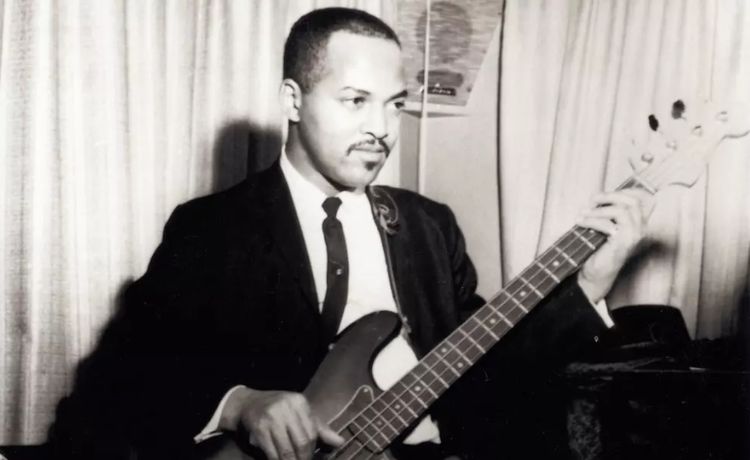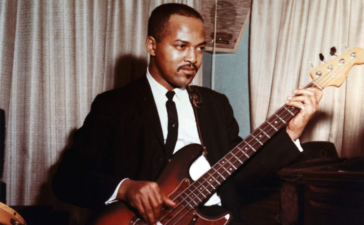James Jamerson, born on January 29, 1936, in Edisto Island, South Carolina, and raised in Detroit, Michigan, is considered one of the most influential bassists of all time. As the uncredited but central figure in Motown’s house band, The Funk Brothers, Jamerson’s innovative and intricate basslines played a key role in shaping the “Motown sound” that defined an era of American music. His work set the foundation for countless hits that would go on to define 1960s and early 1970s soul and R&B.
Early Life and Musical Roots
Jamerson’s early musical influences were shaped by both his Southern roots and his exposure to jazz and gospel music in Detroit. His family moved to Detroit during the Great Migration, a movement of African Americans from the South to northern cities for better opportunities. It was here that Jamerson honed his musical skills. Although he started on the piano, he eventually transitioned to the upright bass during his time in high school. His formal musical education at Cass Technical High School, combined with his exposure to Detroit’s vibrant jazz scene, laid the groundwork for his legendary career as a bassist.
Rise to Fame at Motown
Jamerson’s big break came when he was recruited by Berry Gordy to join the Motown label in the late 1950s. He became a key member of The Funk Brothers, the session musicians responsible for playing on the majority of Motown hits from the 1960s. Jamerson’s distinctive basslines, deeply rooted in jazz, were a driving force behind the success of countless Motown artists.
Some of Jamerson’s most iconic contributions can be heard on songs such as:
- “My Girl” by The Temptations
- “Ain’t No Mountain High Enough” by Marvin Gaye and Tammi Terrell
- “Bernadette” by The Four Tops
- “I Heard It Through the Grapevine” by Marvin Gaye
These tracks showcased Jamerson’s ability to create melodic, syncopated basslines that added a level of complexity and richness to the music while still driving the rhythm. His innovative style blended elements of jazz improvisation with the strong groove of R&B, which was unprecedented in popular music at the time.
Revolutionary Bass Techniques
Jamerson is best known for his use of the Fender Precision Bass, specifically a 1962 model nicknamed “The Funk Machine”. He played with an unusual technique known as the “hook”—plucking the bass strings with just one finger (his right index finger), which he called “The Hook.” This technique, combined with his intricate harmonic knowledge, helped Jamerson create basslines that were not just supportive but central to the musical arrangement.
What made Jamerson truly unique was his refusal to simplify his basslines for radio-friendliness. He brought a jazz-like complexity to his playing that challenged the conventional role of the bass as merely a rhythmic foundation. Tracks like “For Once in My Life” by Stevie Wonder are perfect examples of his harmonically rich and rhythmically complex lines that elevated the entire track.
Recognition and Struggles
Despite his enormous contribution to Motown’s success, Jamerson, like many session musicians at the time, remained largely uncredited on the records. His playing was so distinct, however, that fellow musicians and bass enthusiasts could identify his signature sound.
Unfortunately, while his career was soaring in the 1960s, his personal life was more tumultuous. As Motown began moving from Detroit to Los Angeles in the 1970s, Jamerson struggled to maintain his status in the music industry. By this time, he was battling alcoholism, which took a toll on his career and personal life. Despite these challenges, he continued to play on major recordings into the 1970s, including his celebrated work on Marvin Gaye’s What’s Going On (1971), which is still hailed as one of the greatest albums ever made.
Later Years and Legacy
James Jamerson passed away on August 2, 1983, at the age of 47, due to complications from cirrhosis, heart failure, and pneumonia. At the time of his death, his contributions to music had not yet been widely recognized outside of musician circles, but in the years since, Jamerson’s reputation has only grown.
His posthumous recognition includes:
- Induction into the Rock and Roll Hall of Fame as part of the first class of “sidemen” in 2000.
- The documentary “Standing in the Shadows of Motown” (2002), which spotlighted Jamerson and The Funk Brothers, finally giving them the recognition they deserved.
Jamerson’s innovative playing continues to influence bassists across genres. Paul McCartney, John Entwistle of The Who, and Jaco Pastorius all cited Jamerson as a significant influence on their work. His ability to elevate bass playing from a supportive to a melodic role helped pave the way for generations of musicians to follow.
Conclusion
James Jamerson revolutionized the role of the bass guitar in modern music. His work with Motown created a lasting legacy, one that defines an entire era of American music. Though he faced struggles in his personal life and was underappreciated during his career, his influence has only grown over time, ensuring his place in the pantheon of the greatest musicians in history. His unique bass playing helped make Motown’s music timeless, and his techniques and innovations continue to inspire musicians to this day.









